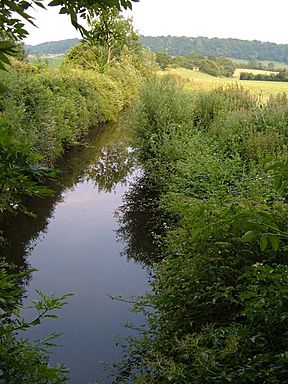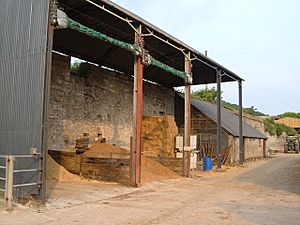Chard Canal facts for kids
The Chard Canal was a special waterway built in Somerset, England. It was about 13.5 miles (21.7 km) long. This canal connected Creech St. Michael to Chard.
It was designed for small boats called tub boats. To handle the hilly land, it used four aqueducts (bridges for water), three tunnels, and four inclined planes. These planes were like ramps that moved boats up and down. The canal was finished in 1842. However, it never made much money and closed in 1868. Today, you can still see many of its old engineering parts in the landscape.
Contents
Why Build a Canal?
For many years, people wanted to build a canal across England. This would connect the Bristol Channel to the English Channel. It would help ships avoid the long and dangerous trip around Cornwall and Devon.
- In 1769, Robert Whitworth first suggested a route through Chard.
- He looked at the idea again in the 1790s and thought it was possible.
- In 1793, the Chard Canal plan was brought up again.
- By 1809, it was called the English and Bristol Channels Canal.
- John Rennie surveyed it in 1810. He thought a small ship canal for vessels up to 120 tons was best.
- This ship canal would cost a lot of money, much more than a barge canal.
Another attempt was made in 1825 for a larger ship canal. This canal would carry ships up to 200 tons. It would need 30 locks and connect Stolford to Beer. Thomas Telford surveyed this route. An Act of Parliament was passed in 1825. Even though people promised a lot of money, the plan never went forward.
Building the Chard Canal
After the Bridgwater and Taunton Canal opened in 1827, people wanted to link Chard to it. James Green surveyed the route in 1831. Chard was about 231 feet (70 m) higher than the canal at Creech St Michael. Green's plan included two boat lifts and two inclined planes. It was estimated to cost £57,000.
- An Act of Parliament was approved in June 1834. This allowed them to raise money.
- However, local people were not very excited about the project.
- Most of the money came from just five men. These men were also involved in the Bridgwater and Taunton Canal.
Work started in June 1835 at Wrantage. James Green was replaced by Sydney Hall as the engineer. Green had problems with boat lifts on another canal. So, Hall decided to use inclined planes instead of boat lifts.
More changes were made during construction. Another tunnel was built above the Ilminster inclined plane. This allowed the canal to be built at a lower level. A lock was added at Bere Mills to raise the canal by 7 feet (2.1 m). The Chard incline was also made longer.
Building the canal cost much more than expected.
- More money was needed, so another Act of Parliament was passed in 1840.
- A third Act in 1841 allowed construction to continue past the original deadline.
- The canal opened to Ilminster on May 15, 1841.
- It opened fully to Dowlish Ford wharfs on February 3, 1842.
There were some delays. A rope on the Wrantage plane broke. Also, the Bristol and Exeter Railway built their line under the canal at Creech. The canal was finally completed on May 24, 1842.
The canal helped the local area. For example, coal prices dropped. But the total cost was about £140,000. The canal earned only a third of what was expected. The company could not even pay the interest on its debts.
How the Canal Worked
The Chard Canal used small tub-boats. These boats were about 26 by 6.5 feet (7.9 by 2.0 m). The canal had special inclined planes at Thornfalcon, Wrantage, and Ilminster.
- These were double-acting inclines. They had two parallel tracks.
- Each track had a large box called a caisson. Boats floated inside these caissons.
- A chain connected the two caissons. It went around a drum at the top of the incline.
- To move boats, the top caisson was filled with extra water. Its weight pulled it down, and the other caisson went up.
- This system used less water than traditional locks. A large new Chard Reservoir supplied the water needed.
The incline at Chard Common was different.
- It had a single track. Tub-boats were carried on a wheeled cradle.
- A water turbine powered the movement. It used a lot of water per minute.
- Boats were raised 86 feet (26 m) up a slope. A strong wire rope connected the cradle to the turbine.
The Ilminster tunnel was 14 feet (4.3 m) wide, allowing two boats to pass. But the tunnels at Lillesdon and Crimson Hill were only wide enough for one boat. However, Crimson Hill Tunnel had a wider "passing area" in the middle.
The main goods carried were coal and stone. Traffic increased in the first three years. About two-thirds of the cargo was coal.
However, the canal faced competition. The railway arrived in Taunton in 1842. The Westport Canal was also completed in 1840. People tried to turn the Chard Canal into a railway. An Act of Parliament in 1847 changed the company's name to the Chard Railway Company. But the company could not pay its debts.
The canal went into financial trouble in 1853. Discussions began with railway companies. The Bristol and Exeter Railway bought the Chard Canal for £5,945. This was to stop other railway companies from using it. The canal officially closed in February 1868.
What Remains Today
The Chard Reservoir, which supplied water to the canal, is now a nature reserve. It is surrounded by woods and is home to over 150 types of birds.
The remains of the inclined planes and the three tunnels are still visible. Near Lower Farm, a bridge that carried the canal is now a listed building. The three-arched aqueduct that carried the canal over the River Tone is mostly still there.
During World War II, part of the Taunton Stop Line defence project followed the canal's route.
Canal Locations
| Point | Coordinates (Links to map resources) |
OS Grid Ref | Notes |
|---|---|---|---|
| Taunton Junction | 51°01′30″N 3°02′31″W / 51.025°N 3.042°W | ST269256 | Where it joined the Bridgwater and Taunton Canal |
| Ruishton Aqueduct | 51°01′12″N 3°02′24″W / 51.020°N 3.040°W | ST271250 | |
| Thornfalcon Plane | 51°00′43″N 3°01′34″W / 51.012°N 3.026°W | ST280241 | 28 ft (8.5m) rise, with balanced caissons |
| Lillesdon Tunnel | 51°00′22″N 3°00′14″W / 51.006°N 3.004°W | ST296234 | 314 yd (287m) long |
| Wrantage Aqueduct | 50°59′53″N 2°59′13″W / 50.998°N 2.987°W | ST308225 | |
| Wrantage Plane | 50°59′38″N 2°59′02″W / 50.994°N 2.984°W | ST310220 | 27.5 ft (8.4m) rise, with balanced caissons |
| Crimson Hill Tunnel N | 50°59′42″N 2°58′30″W / 50.995°N 2.975°W | ST316221 | 1800 yd (1.6km) long |
| Crimson Hill Tunnel S | 50°58′55″N 2°57′50″W / 50.982°N 2.964°W | ST324207 | 1800 yd (1.6km) long |
| Ilminster Plane | 50°55′26″N 2°55′01″W / 50.924°N 2.917°W | ST356142 | 82.5 ft (25.2m) rise, with balanced caissons |
| Ilminster Tunnel | 50°55′16″N 2°54′50″W / 50.921°N 2.914°W | ST358138 | 300 yd (275m) long |
| Bere Mills Lock | 50°54′22″N 2°55′23″W / 50.906°N 2.923°W | ST351122 | 7 ft (2.1m) rise |
| Chard Common Plane | 50°53′10″N 2°56′13″W / 50.886°N 2.937°W | ST340100 | 86 ft (26.2m) rise, single track |
| Chard Basin | 50°52′44″N 2°57′14″W / 50.879°N 2.954°W | ST329092 | End point of the canal |



